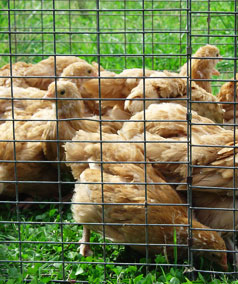
Successfully transitioning young poultry from their brooder to permanent outdoor facilities requires following a few common-sense guidelines. First determine that the birds are ready to move from their brooder, taking into consideration such factors as how well feathered the birds are, and outdoor temperatures during both daytime and nighttime.
Degree of Feathering
Fully-feathered poultry are generally ready for a permanent move to outdoor housing. How fast poultry feather out depends on the species, breed and brooding temperature. As a general rule, you can expect:
- chickens to fully feather at approximately 5 to 6 weeks
- ducks to fully feather at approximately 7 to 9 weeks
- turkeys to fully feather at approximately 8 to 10 weeks.
Within each species, different breeds feather at different rates. Speed of feathering also depends on brooding temperature. Within the birds’ comfort zone, a temperature slightly on the warm side will result in slow feathering, while a temperature slightly on the cool side will increase the rate of feathering.
Ambient Temperature
An often-stated rule of thumb is that the brooding temperature should start at 95ºF and be reduced 5ºF per week for the first six weeks, or until the brooder temperature is the same as the daytime temperature outdoors. At that point, young poultry should no longer require auxiliary heat and can safely be moved outdoors.
Of course, that’s assuming the ambient temperature is 65ºF to 70ºF. A lower ambient temperature can require a longer brooding period. On the other hand, if the outdoor temperature is higher than brooding temperature and conditions are dry, young poultry may be moved out of the brooder sooner.
Weather conditions are a big factor in determining the best timing. Where turkeys are involved, many growers keep their birds off the ground until they are at least 12 weeks old, to avoid damp or chilling weather conditions that can kill young turkeys.
Ducks love wet conditions, but they too will suffer if they get chilled. Because ducks make such a mess in the brooder, they might be moved to a protected outdoor facility at an early age. Alternatively, you could put them outdoors on warm days and bring them back in at night.
Gradual Transition
A big factor in successfully moving young poultry from the brooder is to make a gradual adjustment to let the birds get acclimated to outdoor conditions. Birds that no longer require brooder heat will acclimate rather quickly. Never abruptly move poultry from a heated brooder to permanent outdoor facilities. Where nights are chilly, you might bring the birds back indoors overnight. Or, you might continue providing heat in the outdoor coop, at least during the night.
Acclimation to lights-out at night is another important transitional measure. Before chicks are moved to an outside coop, they should get used to having the brooder lights dimmed or turned off at night. Lights that go off suddenly at night can scare the birds and result in a pileup — birds piling on top of one another, smothering those unfortunate enough to find themselves at the bottom. Because pileups occur most often after dark, birds that learn to bed down naturally as dusk falls generally will not pile.
Another acclimation option is to furnish brooded birds with a sunporch fully enclosed with hardware cloth, where they can choose to spend time outdoors during the daytime. A sunporch, made available when chicks are 3 to 4 weeks old, allows the birds to acclimate at their own pace. Every evening for the first week after opening access to the sunporch, make sure the birds have gone back inside for the night.
After the birds are moved to the outdoor coop, keep them confined inside for the first few days before opening the door to the outside run. Once they are given access to a run, check every evening for the first week or so, to see that they go back inside. Birds that remain in a cold, damp, drafty run overnight may pile or chill.
Number of Birds
Additional transitional measures relate to the number of young birds in relation to the size of the outdoor housing. A sizable number of birds may generate enough heat to keep themselves warm overnight, assuming their housing is not damp or drafty. Just a few birds in a big coop, however, might need a little help, such as confining them to a smaller portion of the coop, or providing them with auxiliary heat until nighttime temperatures improve.
The natural instinct of chilled poultry is to huddle together to stay warm. Huddling can result in pileups. Temporarily rounding the coop’s corners helps prevent young birds from getting trapped in a pileup. Corners may be rounded with boards or stiff cardboard, or each afternoon bedding may be pushed into an incline at all corners.
Piling may also occur when chicks are moved from a brooder with a low overhead to a coop with a high ceiling, where they feel less safe. An easy fix is to prop a small sheet of plywood on blocks at the four corners, giving the chicks a place to safely “hide” underneath.
By gradually transitioning your birds — and taking into consideration outdoor temperatures, the number of birds and their degree of feathering — you can successfully move young poultry from their brooder to permanent outdoor facilities.
And that’s today’s news from the Cackle Coop.
Gail Damerow is the author of Hatching and Brooding Your Own Chicks

